MaryAnn Bernal's Blog, page 199
February 4, 2015
History Trivia - Roman Emperor Septimius Severus dies at York
February 4
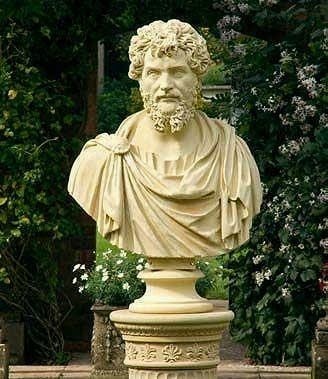
211 Roman emperor Septimius Severus died at York while campaigning to subdue northern Britain, leaving the Roman Empire in the hands of his two quarrelsome sons, Caracalla and Geta.
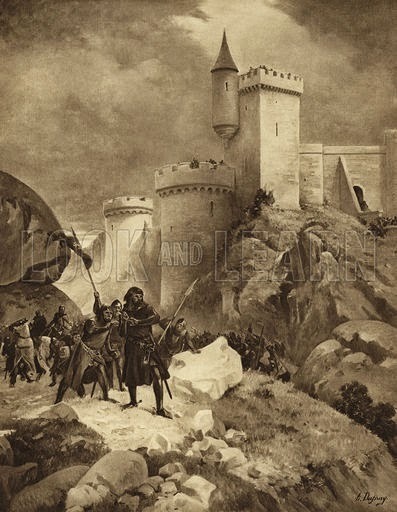
1194 King Richard I of England was freed by Henry VI, Holy Roman Emperor, after being ransomed. Richard did return to England but soon set sail for France where he died five years later.

1586 Robert Dudley, earl of Leicester, became governor of Neth (Netherlands).

211 Roman emperor Septimius Severus died at York while campaigning to subdue northern Britain, leaving the Roman Empire in the hands of his two quarrelsome sons, Caracalla and Geta.

1194 King Richard I of England was freed by Henry VI, Holy Roman Emperor, after being ransomed. Richard did return to England but soon set sail for France where he died five years later.

1586 Robert Dudley, earl of Leicester, became governor of Neth (Netherlands).
Published on February 04, 2015 03:00
February 3, 2015
Prehistoric High Times: Early Humans Used Magic Mushrooms, Opium
by Agata Blaszczak-Boxe
Live Science
 Mayan ruins: Chichen Itza Pyramid, in Mexico.
Mayan ruins: Chichen Itza Pyramid, in Mexico.
For example, the evidence shows that people have been chewing the leaves of a plant called the betel since at least 2660 B.C., according to Guerra-Doce's report . The plant contains chemicals that have stimulant- and euphoria-inducing properties, and these days is mostly consumed in Asia. Researchers have found the remains of human teeth that have the characteristic reddish, bloodlike "betel stains" in a burial pit in Duyong Cave on Palawan Island in the southern Philippines, according to the report. [Trippy Tales: The History of 8 Hallucinogens]
. The plant contains chemicals that have stimulant- and euphoria-inducing properties, and these days is mostly consumed in Asia. Researchers have found the remains of human teeth that have the characteristic reddish, bloodlike "betel stains" in a burial pit in Duyong Cave on Palawan Island in the southern Philippines, according to the report. [Trippy Tales: The History of 8 Hallucinogens]
Researchers have also found the reddish stains on the teeth of human remains that date between 2400 and 2000 B.C., and that were excavated from the Bronze Age site of Nui Nap in Vietnam. In that case, the teeth were stained by betel nuts, and it is possible that it was used for aesthetic reasons, as opposed to being used because of its psychoactive properties.
San Pedro cactus
These days, San Pedro cactus — which contains chemicals with hallucinogenic properties — is used in healing ceremonies by people living in the Andean mountains of South America, primarily in northern Peru, according to Guerra-Doce's paper. But the earliest evidence of San Pedro cactus usewas found in Guitarrero Cave, in Peru's Callejón de Huaylas valley. Researchers found pollen and traces of the cactus in the parts of the cave that were occupied the earliest, which date back to between 8600 and 5600 B.C.
of the cave that were occupied the earliest, which date back to between 8600 and 5600 B.C.
Other evidence shows that a larger sample of material from the cactus found in the cave dated back to 6800-6200 B.C., according to the paper.
'Magic' mushrooms
The use of hallucinogenic mushrooms in Mesoamerica has been documented, thanks to the discovery of so-called mushroom stones, which are small sculptures resembling a mushroom. The sculptures have been found at numerous sites dating back to between 500 B.C. and A.D. 900 in Guatemala, Mexico, Honduras and El Salvador, according to the paper.
of so-called mushroom stones, which are small sculptures resembling a mushroom. The sculptures have been found at numerous sites dating back to between 500 B.C. and A.D. 900 in Guatemala, Mexico, Honduras and El Salvador, according to the paper.
It's less clear how long ago magic mushrooms may have been used in Africa and Europe, according to Guerra-Doce. However, there are mushroom-looking pictographs in the prehistoric mural paintings found at Villar del Humo in Cuenca, Spain, which may represent hallucinogenic mushrooms.
Opium poppy
The earliest evidence of opium poppy use in Europe comes from the Neolithic site of La Marmotta in Italy, which dates back to the mid-sixth millennium B.C., according to the study. The domestication of the plant in Europe likely began around that time, in the western Mediterranean, and then spread to northwestern Europe by the end of that millennium.
"Apart from its use as a food plant, there is also uncontested evidence for the exploitation of its narcotic properties," Guerra-Doce wrote in the review. For instance, traces of an opium poppy capsule were found on the teeth of a male skeleton buried at a mining site near Barcelona that dates back to the fourthmillennium B.C. Traces of opiates were also found in the bones of another male buried at the site.
Tobacco
It is not clear exactly when humans started using tobacco, but it is generally assumed that the plant was native to South America, according to the study. Pipes for smoking have been discovered in northwestern Argentine archaeological sites that date to 2100 B.C.
Researchers suspect the pipes were used for smoking either tobacco or other hallucinogenic plants, according to the paper.
Nicotine has been detected in the hair of mummies from several periods within the pre-Hispanic times in South America, according to the paper. In North America, the oldest smoking pipes found date back to the second millennium B.C.; however, these pipes could have also been used for smoking other plants, Guerra-Doce reported in the study.The earliest remains of actual nicotine in a pipe in North America date to 300 B.C.
in the study.The earliest remains of actual nicotine in a pipe in North America date to 300 B.C.
The review was published online Jan. 2 in Time and Mind: The Journal of Archaeology, Consciousness and Culture.
Live Science
 Mayan ruins: Chichen Itza Pyramid, in Mexico.
Mayan ruins: Chichen Itza Pyramid, in Mexico.For example, the evidence shows that people have been chewing the leaves of a plant called the betel since at least 2660 B.C., according to Guerra-Doce's report
 . The plant contains chemicals that have stimulant- and euphoria-inducing properties, and these days is mostly consumed in Asia. Researchers have found the remains of human teeth that have the characteristic reddish, bloodlike "betel stains" in a burial pit in Duyong Cave on Palawan Island in the southern Philippines, according to the report. [Trippy Tales: The History of 8 Hallucinogens]
. The plant contains chemicals that have stimulant- and euphoria-inducing properties, and these days is mostly consumed in Asia. Researchers have found the remains of human teeth that have the characteristic reddish, bloodlike "betel stains" in a burial pit in Duyong Cave on Palawan Island in the southern Philippines, according to the report. [Trippy Tales: The History of 8 Hallucinogens]Researchers have also found the reddish stains on the teeth of human remains that date between 2400 and 2000 B.C., and that were excavated from the Bronze Age site of Nui Nap in Vietnam. In that case, the teeth were stained by betel nuts, and it is possible that it was used for aesthetic reasons, as opposed to being used because of its psychoactive properties.
San Pedro cactus
These days, San Pedro cactus — which contains chemicals with hallucinogenic properties — is used in healing ceremonies by people living in the Andean mountains of South America, primarily in northern Peru, according to Guerra-Doce's paper. But the earliest evidence of San Pedro cactus usewas found in Guitarrero Cave, in Peru's Callejón de Huaylas valley. Researchers found pollen and traces of the cactus in the parts
 of the cave that were occupied the earliest, which date back to between 8600 and 5600 B.C.
of the cave that were occupied the earliest, which date back to between 8600 and 5600 B.C.Other evidence shows that a larger sample of material from the cactus found in the cave dated back to 6800-6200 B.C., according to the paper.
'Magic' mushrooms
The use of hallucinogenic mushrooms in Mesoamerica has been documented, thanks to the discovery
 of so-called mushroom stones, which are small sculptures resembling a mushroom. The sculptures have been found at numerous sites dating back to between 500 B.C. and A.D. 900 in Guatemala, Mexico, Honduras and El Salvador, according to the paper.
of so-called mushroom stones, which are small sculptures resembling a mushroom. The sculptures have been found at numerous sites dating back to between 500 B.C. and A.D. 900 in Guatemala, Mexico, Honduras and El Salvador, according to the paper.It's less clear how long ago magic mushrooms may have been used in Africa and Europe, according to Guerra-Doce. However, there are mushroom-looking pictographs in the prehistoric mural paintings found at Villar del Humo in Cuenca, Spain, which may represent hallucinogenic mushrooms.
Opium poppy
The earliest evidence of opium poppy use in Europe comes from the Neolithic site of La Marmotta in Italy, which dates back to the mid-sixth millennium B.C., according to the study. The domestication of the plant in Europe likely began around that time, in the western Mediterranean, and then spread to northwestern Europe by the end of that millennium.
"Apart from its use as a food plant, there is also uncontested evidence for the exploitation of its narcotic properties," Guerra-Doce wrote in the review. For instance, traces of an opium poppy capsule were found on the teeth of a male skeleton buried at a mining site near Barcelona that dates back to the fourthmillennium B.C. Traces of opiates were also found in the bones of another male buried at the site.
Tobacco
It is not clear exactly when humans started using tobacco, but it is generally assumed that the plant was native to South America, according to the study. Pipes for smoking have been discovered in northwestern Argentine archaeological sites that date to 2100 B.C.
Researchers suspect the pipes were used for smoking either tobacco or other hallucinogenic plants, according to the paper.
Nicotine has been detected in the hair of mummies from several periods within the pre-Hispanic times in South America, according to the paper. In North America, the oldest smoking pipes found date back to the second millennium B.C.; however, these pipes could have also been used for smoking other plants, Guerra-Doce reported
 in the study.The earliest remains of actual nicotine in a pipe in North America date to 300 B.C.
in the study.The earliest remains of actual nicotine in a pipe in North America date to 300 B.C.The review was published online Jan. 2 in Time and Mind: The Journal of Archaeology, Consciousness and Culture.
Published on February 03, 2015 07:36
Cambridge University team discovers possible Michelangelo bronzes
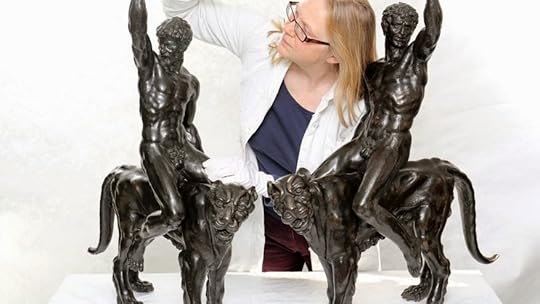
Dr Victoria Avery, keeper of applied arts at the Fitzwilliam Museum at the University of Cambrdige examines two bronze sculptures thought to be works by Michelangelo. (AP Photo/PA, Chris Radburn)
Fox News
It’s a discovery that is reverberating throughout the art world – a University of Cambridge-led research team believes that they have discovered the only surviving Michelangelo bronze statues. Last fall, Paul Joannides, emeritus professor of art history at Cambridge, traced two three feet-high bronze male nude figures to a drawing by a Michelangelo apprentice that resides at the Musée Fabre in Montpellier, France, according to a Cambridge press release.
The non-matching figures — one is an older male, the other younger, but both are depicted riding a panther — were initially credited to Michelangelo when they were featured as part of Adolphe de Rothschild’s 19th century collection. Since the figures were undocumented, historians dismissed this attribution. Joannides found a student’s 16th century sketch sheet filled with copies of early Michelangelo works. One of the sketches depicts a young athletic male figure riding a panther, which mirrors the pose of the statues. The sketch is drawn in the same style that Michelangelo used when creating designs for his sculptures.
“It has been fantastically exciting to have been able to participate in this ground-breaking project” Victoria Avery, keeper of the applied arts department of Cambridge's Fitzwilliam Museum, said in the release. The project “involved input from many art historians in the U.K., Europe and the States, and to draw on evidence from conservation scientists and anatomists.”The international research team behind the project compared the two statues to other Michelangelo pieces, tracing similarities to some of the artist’s work that stretched from 1500 to 1510. More testing is being done, and the team plans to release their findings at an international conference on July 6, 2015.
The bronze statues and some evidence from the research team are currently being displayed at the Fitzwilliam Museum’s Italian galleries until August.
“The bronzes are exceptionally powerful and compelling works of art that deserve close-up study,” Avery said.
Published on February 03, 2015 07:28
Brooklyn and Bo Chronicles by Brenda Perlin: LA Punk Rocker, presented by Brenda Perlin
Brooklyn and Bo Chronicles by Brenda Perlin: LA Punk Rocker, presented by Brenda Perlin: The first real punk band I had ever heard of was The Sex Pistols even though they were pretty much over by the time I discovered them. By...
LA Punk Rocker, presented by Brenda Perlin The first real punk band I had ever heard of was The Sex Pistols even though they were pretty much over by the time I discovered them. By the end of 1978, the Sex Pistols had broken up, and Sid Vicious was found dead from a heroin overdose in New York on February 1, 1979.

L.A. Punk Rocker is filled with raw stories about growing up on the streets of Los Angeles and the passion for music with an attitude. Revisit the eclectic style of the eighties!
Back when U2 were practically unknown, Bad Religion and the Go Go’s played small venues and Billy Idol was sporting his famous scowl. A time when Hollywood was abuzz with new music. Capital records swap-meat, Danny’s Dogs and Errol Flynn’s mansion were places we spent our nights when we weren’t listening to live bands at the Starwood or the Whiskey on Sunset.
We were rebels with a very good cause. We were creative outcasts who got tired of getting abused at school just for being different.
Even though being accepted was never easy and I always had to seek my parents approval for everything, these were the best times of my life. It was then when I had my first taste of freedom. During my punk rocker days I realized it was okay to be an individual.

Many thanks to the contributors of this book that have donated their stories just because their passion lives. The brilliant author Mark Barry motivated me to visit this #LAPUNKQUEEN and it is because of him that L.A. Punk Rocker is a reality. I adore his enthusiasm and great love of music. Much praise to MAB who has been a great help to me with my writing projects. Without her, my books would not exist on Amazon.- See more at: http://brooklynandbochronicles.blogspot.com/2015/01/la-punk-rocker-presented-by-brenda.html#sthash.7uJtuHrh.v1UQgobY.dpuf
LA Punk Rocker, presented by Brenda Perlin The first real punk band I had ever heard of was The Sex Pistols even though they were pretty much over by the time I discovered them. By the end of 1978, the Sex Pistols had broken up, and Sid Vicious was found dead from a heroin overdose in New York on February 1, 1979.

L.A. Punk Rocker is filled with raw stories about growing up on the streets of Los Angeles and the passion for music with an attitude. Revisit the eclectic style of the eighties!
Back when U2 were practically unknown, Bad Religion and the Go Go’s played small venues and Billy Idol was sporting his famous scowl. A time when Hollywood was abuzz with new music. Capital records swap-meat, Danny’s Dogs and Errol Flynn’s mansion were places we spent our nights when we weren’t listening to live bands at the Starwood or the Whiskey on Sunset.
We were rebels with a very good cause. We were creative outcasts who got tired of getting abused at school just for being different.
Even though being accepted was never easy and I always had to seek my parents approval for everything, these were the best times of my life. It was then when I had my first taste of freedom. During my punk rocker days I realized it was okay to be an individual.

Many thanks to the contributors of this book that have donated their stories just because their passion lives. The brilliant author Mark Barry motivated me to visit this #LAPUNKQUEEN and it is because of him that L.A. Punk Rocker is a reality. I adore his enthusiasm and great love of music. Much praise to MAB who has been a great help to me with my writing projects. Without her, my books would not exist on Amazon.- See more at: http://brooklynandbochronicles.blogspot.com/2015/01/la-punk-rocker-presented-by-brenda.html#sthash.7uJtuHrh.v1UQgobY.dpuf
Published on February 03, 2015 07:17
History Trivia - Battle of Mortimer's Cross The Yorkists defeat Lancastrians
February 3
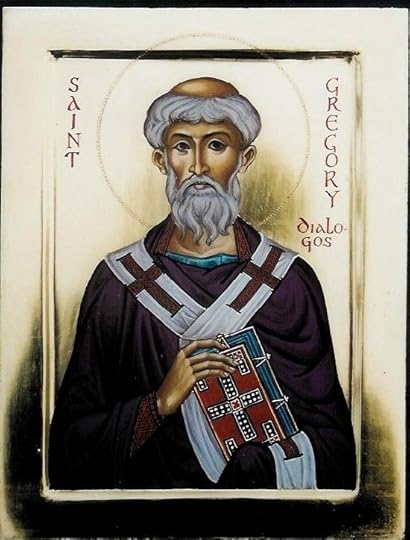
590 Gregory I, the Great, was elected Roman Catholic pope. He is known as the Father of Christian Worship because of his liturgical reforms.
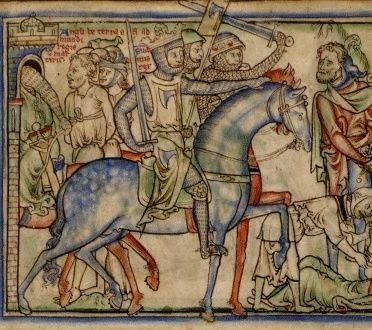
1014 King Sweyn I (Forkbeard) of Denmark died. The Viking leader established a Danish empire, gained control of Norway, and conquered England. His name appears as Swegen in the Anglo-Saxon Chronicle.

1461 Battle of Mortimer's Cross The Yorkists, led by the future Edward IV, defeated Lancastrian forces in this significant battle of the Wars of the Roses

590 Gregory I, the Great, was elected Roman Catholic pope. He is known as the Father of Christian Worship because of his liturgical reforms.

1014 King Sweyn I (Forkbeard) of Denmark died. The Viking leader established a Danish empire, gained control of Norway, and conquered England. His name appears as Swegen in the Anglo-Saxon Chronicle.

1461 Battle of Mortimer's Cross The Yorkists, led by the future Edward IV, defeated Lancastrian forces in this significant battle of the Wars of the Roses
Published on February 03, 2015 02:30
February 2, 2015
British Library reunites Magna Carta copies for 800th anniversary
Mark BrownThe Guardian
 The four surviving copies of the Magna Carta being prepared for display at the British Library. Photograph: Clare Kendall/British Library/PA Four copies of groundbreaking document to be assembled at British Library – but only 1,215 people who won a ballot can see them
The four surviving copies of the Magna Carta being prepared for display at the British Library. Photograph: Clare Kendall/British Library/PA Four copies of groundbreaking document to be assembled at British Library – but only 1,215 people who won a ballot can see them
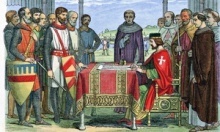
The only remaining original copies of Magna Carta, one of the world’s most enduringly influential documents, are to on Monday be brought together for the first and probably only time.Two copies in the British Library’s collection will be joined by one from Lincoln Cathedral and one from Salisbury Cathedral to mark the 800th anniversary of an agreement that has become a symbol of liberty and law.
The four copies will remain at the British Library for three days. On Tuesday 1,215 people who won a ballot to see them – randomly selected from 43,715 applicants from 20 countries – will be given access.
The following day, the world’s leading academic experts on the document will get their turn, part of a research project funded by the Arts and Humanities Research Council.
On Thursday, the manuscripts will travel to the House of Lords before being returned to their separate homes and exhibitions. The British Library’s display, Magna Carta: Law, Liberty, Legacy, runs from 13 March to 1 September. All four copies have differences, including their shape, with one of the two at the British Library and the Salisbury version being in portrait format, while the Lincoln copy is square and the other British Library version is landscape.
Claire Breay, head of medieval manuscripts at the British Library, said: “Magna Carta is one of the most famous documents in the world, let alone one of the most important things we have in the collections at the British Library. We’ve been working towards this with Lincoln and Salisbury since 2010, so it is very exciting to see it come to fruition.”King John agreed the terms of the charter at Runnymede in 1215, sealing it on 15 June. Most of Magna Carta’s clauses dealt with specific grievances England’s barons had with the king, but buried within the document are agreements that have become totemic across the world, not least the 39th article giving all “free men” the right to a fair trial.
At least 13 copies were made on sheepskin parchment and sent out to bishops. The two copies in the British Library came into the national collection in 1753 as part of the enormous library of the MP and antiquary Sir Robert Cotton.
Seeing Magna Carta is an almost spiritual event for many visitorsto the Library . Breay said: “People really want to have stood in front of this incredibly famous document. Even though it is written in medieval Latin and in medieval handwriting and most people can’t actually read it, people recognise its historic and symbolic importance as a symbol of freedom and rights and liberties.”
She said it seemed a fitting start to the Magna Carta anniversary. “It is a unique opportunity, a never-to-be-repeated opportunity, to see them side by side.”
 The four surviving copies of the Magna Carta being prepared for display at the British Library. Photograph: Clare Kendall/British Library/PA Four copies of groundbreaking document to be assembled at British Library – but only 1,215 people who won a ballot can see them
The four surviving copies of the Magna Carta being prepared for display at the British Library. Photograph: Clare Kendall/British Library/PA Four copies of groundbreaking document to be assembled at British Library – but only 1,215 people who won a ballot can see them 
The only remaining original copies of Magna Carta, one of the world’s most enduringly influential documents, are to on Monday be brought together for the first and probably only time.Two copies in the British Library’s collection will be joined by one from Lincoln Cathedral and one from Salisbury Cathedral to mark the 800th anniversary of an agreement that has become a symbol of liberty and law.
The four copies will remain at the British Library for three days. On Tuesday 1,215 people who won a ballot to see them – randomly selected from 43,715 applicants from 20 countries – will be given access.
The following day, the world’s leading academic experts on the document will get their turn, part of a research project funded by the Arts and Humanities Research Council.
On Thursday, the manuscripts will travel to the House of Lords before being returned to their separate homes and exhibitions. The British Library’s display, Magna Carta: Law, Liberty, Legacy, runs from 13 March to 1 September. All four copies have differences, including their shape, with one of the two at the British Library and the Salisbury version being in portrait format, while the Lincoln copy is square and the other British Library version is landscape.
Claire Breay, head of medieval manuscripts at the British Library, said: “Magna Carta is one of the most famous documents in the world, let alone one of the most important things we have in the collections at the British Library. We’ve been working towards this with Lincoln and Salisbury since 2010, so it is very exciting to see it come to fruition.”King John agreed the terms of the charter at Runnymede in 1215, sealing it on 15 June. Most of Magna Carta’s clauses dealt with specific grievances England’s barons had with the king, but buried within the document are agreements that have become totemic across the world, not least the 39th article giving all “free men” the right to a fair trial.
At least 13 copies were made on sheepskin parchment and sent out to bishops. The two copies in the British Library came into the national collection in 1753 as part of the enormous library of the MP and antiquary Sir Robert Cotton.
Seeing Magna Carta is an almost spiritual event for many visitorsto the Library . Breay said: “People really want to have stood in front of this incredibly famous document. Even though it is written in medieval Latin and in medieval handwriting and most people can’t actually read it, people recognise its historic and symbolic importance as a symbol of freedom and rights and liberties.”
She said it seemed a fitting start to the Magna Carta anniversary. “It is a unique opportunity, a never-to-be-repeated opportunity, to see them side by side.”
Published on February 02, 2015 05:31
History Trivia - Second battle of St Alban's- Lancastrians defeat Yorkists
February 2

506 The Breviarium Alaricianum or Lex Romana Visigothorum, a collection of Roman law, was drafted at Toulouse under Alaric II, King of the Visigoths.

962 Pope John XII crowned Otto I, Holy Roman Emperor, the first Holy Roman Emperor in nearly 40 years.

1461 England's Wars of the Roses: Second battle of St Alban's- Lancastrians defeated Yorkists.

1461 Owen Tudor, Welsh founder of the Tudor dynasty of England died.

506 The Breviarium Alaricianum or Lex Romana Visigothorum, a collection of Roman law, was drafted at Toulouse under Alaric II, King of the Visigoths.

962 Pope John XII crowned Otto I, Holy Roman Emperor, the first Holy Roman Emperor in nearly 40 years.

1461 England's Wars of the Roses: Second battle of St Alban's- Lancastrians defeated Yorkists.

1461 Owen Tudor, Welsh founder of the Tudor dynasty of England died.
Published on February 02, 2015 02:00
February 1, 2015
History Trivia - Elizabeth I of England signs the Warrant of Execution for Mary (Queen of Scots).
February 1

772 Adrian I was elected pope. During one of the longest pontificates in history, he forged a strong bond with Charlemagne and presided over the Second Council at Nicea where twenty-two canons relating to points of discipline was established.

1327 Edward III was crowned King of England, but the country was ruled by his mother Queen Isabella and her lover Roger Mortimer.

1587 Elizabeth I of England signed the Warrant of Execution for Mary (Queen of Scots).

772 Adrian I was elected pope. During one of the longest pontificates in history, he forged a strong bond with Charlemagne and presided over the Second Council at Nicea where twenty-two canons relating to points of discipline was established.

1327 Edward III was crowned King of England, but the country was ruled by his mother Queen Isabella and her lover Roger Mortimer.

1587 Elizabeth I of England signed the Warrant of Execution for Mary (Queen of Scots).
Published on February 01, 2015 03:00
January 31, 2015
Has the mystery of Shakespeare’s Sonnets finally been solved?
New evidence points to identity of enigmatic ‘Mr WH’ to whom the poems are dedicated
 A portrait of William Shakespeare from around 1610. Photograph: Oli Scarff/Getty Images
A portrait of William Shakespeare from around 1610. Photograph: Oli Scarff/Getty Images
Dalya Alberge
The Guardian
Some of the finest, most quoted verses in the English language were dedicated to him, and for centuries literary scholars have tried to establish his identity.
Now fresh research suggests that the mysterious Mr WH, to whom Shakespeare’s sonnets were dedicated, was not, as had been thought, a contemporary English nobleman, but a recently deceased associate of the Sonnets’ publisher, Thomas Thorpe, which would explain the dedication’s strangely funereal form.
Geoffrey Caveney, an American researcher, has unearthed possible evidence to link the initials with William Holme, who had both personal and professional connections to Thorpe. Both came from prominent Chester families, were publishing apprentices in 1580s London and had strong connections with theatres through publishing major playwrights such as Ben Jonson and George Chapman.
The Sonnets’ dedication reads: “To the only begetter of these ensuing sonnets Mr WH. All happiness and that eternity promised by our ever-living poet wisheth the well-wishing adventurer in setting forth. TT [Thorpe].”
Some argue that WH was also the “fair youth” to whom many of the 154 sonnets are addressed, or that he was someone thanked for bringing the manuscript to Thorpe. Candidates have included Henry Wriothesley, 3rd Earl of Southampton, a noted patron, and William Herbert, 3rd Earl of Pembroke, with whom Shakespeare is believed to have had some link.
But as aristocrats they would never have been addressed as “Mr”, Caveney said. “It would be an insult. Some people have even said that WH is just a misprint for William Shakespeare and it should have been a WSH.”
He now believes the dedication’s printed page was designed to resemble an inscription on a Roman funerary monument – a memorial tribute to Holme. Caveney discovered that Holme died in 1607, two years before the Sonnets were published. He concludes that Holme had previously been overlooked because he was confused with a stationer, William Holmes, who was known to be publishing up to 1615.
“Nobody was aware that there was [also] a publisher of that name who had died in 1607,” said Caveney. “Seeing the dedication as a memorial makes a lot of sense.” His research will be published this month by Oxford University Press in its academic journal, Notes & Queries.
Advertisement
Professor Stanley Wells, the leading British Shakespeare scholar, said: “If it were agreed by scholars, this would be pretty momentous. People have spilled an enormous quantity of ink trying to identify this figure.”
He described the theory as “better than any other suggestion so far. It’s very interesting.” That it is nobody well known, he added, is “one of the strengths”.
“That it’s not an aristocrat fits in with the fact that it’s Mr WH. That has always been a stumbling block for the attempts to identify him with [aristocrats],” said Wells. He agrees that the fact that it’s a person who was in the publishing trade, linked with Thorpe, and who had recently died all helps to explain the dedication’s funerary form, “which has always also been a mystery”.
But he commented that it will be “less attractive to some people if it’s not an aristocrat”. Those who challenge Shakespeare’s authorship argue that only an aristocrat would have been knowledgeable enough to write his plays, although Wells is among those who dismiss such snobbery, which ignores Elizabethan education and Shakespeare’s background in general.
He added: “It’s also less attractive if it’s not somebody whom we could associate possibly with the substance of the sonnets” – particularly the love poems to that person.
Caveney also finds Holme interesting because he published major playwrights of the day, including Jonson’s Every Man out of His Humour in 1600, and Chapman’s Monsieur D’Olive in 1606. Caveney’s research shows that Holme had a London bookshop and was a close colleague of the printer Adam Islip, who printed Every Man out of His Humour and worked with George Eld, who printed the Sonnets for Thorpe.
Thorpe and Holme both had close relatives who were sheriffs and mayors of Chester. Caveney has discovered evidence that both seem to have had links with prominent Catholic sympathisers of the period and were further connected with supporters of the Earl of Essex’s rebellion in 1601. He said that following the rebellion, and the gunpowder plot four years later, “it was a controversial time for people to be associated with such circles”.
Caveney revealed that Holme had crucial connections to royal circles through his brother, Randle, an antiquarian and authority on heraldry, who was in the service of Prince Henry, giving him close connections with “the elite circles in which Shakespeare’s sonnets would have circulated”.
In Caveney’s essay, he speculates on why Thorpe referred to Holme as the sonnets’ “begetter”. “As a colleague and friend of Holme, Thorpe could have found the manuscript of the Sonnets among Holme’s belongings after his death … Thorpe and his printer, Eld, registered a flurry of plays just nine days after Holme’s burial … How Holme had obtained a copy of the Sonnets cannot be precisely determined, but he had the connections to literary figures.”
Whether supporters of other explanations will be silenced remains to be seen
 A portrait of William Shakespeare from around 1610. Photograph: Oli Scarff/Getty Images
A portrait of William Shakespeare from around 1610. Photograph: Oli Scarff/Getty Images Dalya Alberge
The Guardian
Some of the finest, most quoted verses in the English language were dedicated to him, and for centuries literary scholars have tried to establish his identity.
Now fresh research suggests that the mysterious Mr WH, to whom Shakespeare’s sonnets were dedicated, was not, as had been thought, a contemporary English nobleman, but a recently deceased associate of the Sonnets’ publisher, Thomas Thorpe, which would explain the dedication’s strangely funereal form.
Geoffrey Caveney, an American researcher, has unearthed possible evidence to link the initials with William Holme, who had both personal and professional connections to Thorpe. Both came from prominent Chester families, were publishing apprentices in 1580s London and had strong connections with theatres through publishing major playwrights such as Ben Jonson and George Chapman.
The Sonnets’ dedication reads: “To the only begetter of these ensuing sonnets Mr WH. All happiness and that eternity promised by our ever-living poet wisheth the well-wishing adventurer in setting forth. TT [Thorpe].”
Some argue that WH was also the “fair youth” to whom many of the 154 sonnets are addressed, or that he was someone thanked for bringing the manuscript to Thorpe. Candidates have included Henry Wriothesley, 3rd Earl of Southampton, a noted patron, and William Herbert, 3rd Earl of Pembroke, with whom Shakespeare is believed to have had some link.
But as aristocrats they would never have been addressed as “Mr”, Caveney said. “It would be an insult. Some people have even said that WH is just a misprint for William Shakespeare and it should have been a WSH.”
He now believes the dedication’s printed page was designed to resemble an inscription on a Roman funerary monument – a memorial tribute to Holme. Caveney discovered that Holme died in 1607, two years before the Sonnets were published. He concludes that Holme had previously been overlooked because he was confused with a stationer, William Holmes, who was known to be publishing up to 1615.
“Nobody was aware that there was [also] a publisher of that name who had died in 1607,” said Caveney. “Seeing the dedication as a memorial makes a lot of sense.” His research will be published this month by Oxford University Press in its academic journal, Notes & Queries.
Advertisement
Professor Stanley Wells, the leading British Shakespeare scholar, said: “If it were agreed by scholars, this would be pretty momentous. People have spilled an enormous quantity of ink trying to identify this figure.”
He described the theory as “better than any other suggestion so far. It’s very interesting.” That it is nobody well known, he added, is “one of the strengths”.
“That it’s not an aristocrat fits in with the fact that it’s Mr WH. That has always been a stumbling block for the attempts to identify him with [aristocrats],” said Wells. He agrees that the fact that it’s a person who was in the publishing trade, linked with Thorpe, and who had recently died all helps to explain the dedication’s funerary form, “which has always also been a mystery”.
But he commented that it will be “less attractive to some people if it’s not an aristocrat”. Those who challenge Shakespeare’s authorship argue that only an aristocrat would have been knowledgeable enough to write his plays, although Wells is among those who dismiss such snobbery, which ignores Elizabethan education and Shakespeare’s background in general.
He added: “It’s also less attractive if it’s not somebody whom we could associate possibly with the substance of the sonnets” – particularly the love poems to that person.
Caveney also finds Holme interesting because he published major playwrights of the day, including Jonson’s Every Man out of His Humour in 1600, and Chapman’s Monsieur D’Olive in 1606. Caveney’s research shows that Holme had a London bookshop and was a close colleague of the printer Adam Islip, who printed Every Man out of His Humour and worked with George Eld, who printed the Sonnets for Thorpe.
Thorpe and Holme both had close relatives who were sheriffs and mayors of Chester. Caveney has discovered evidence that both seem to have had links with prominent Catholic sympathisers of the period and were further connected with supporters of the Earl of Essex’s rebellion in 1601. He said that following the rebellion, and the gunpowder plot four years later, “it was a controversial time for people to be associated with such circles”.
Caveney revealed that Holme had crucial connections to royal circles through his brother, Randle, an antiquarian and authority on heraldry, who was in the service of Prince Henry, giving him close connections with “the elite circles in which Shakespeare’s sonnets would have circulated”.
In Caveney’s essay, he speculates on why Thorpe referred to Holme as the sonnets’ “begetter”. “As a colleague and friend of Holme, Thorpe could have found the manuscript of the Sonnets among Holme’s belongings after his death … Thorpe and his printer, Eld, registered a flurry of plays just nine days after Holme’s burial … How Holme had obtained a copy of the Sonnets cannot be precisely determined, but he had the connections to literary figures.”
Whether supporters of other explanations will be silenced remains to be seen
Published on January 31, 2015 07:34
650-Year Drought Triggered Ancient City's Abandonment
by Laura Geggel
Live Science
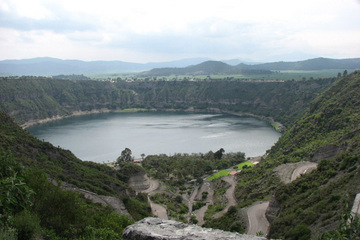
 A lake near Cantona where researchers collected sediment
A lake near Cantona where researchers collected sediment samples to learn about the area's history of drought between A.D. 500 and A.D. 1150.
samples to learn about the area's history of drought between A.D. 500 and A.D. 1150.
Credit : Tripti Bhattacharya
: Tripti Bhattacharya
A once-thriving Mesoamerican metropolis dried up about 1,000 years ago when below-average rainfall triggered centuries-long droughts that largely prompted people to abandon the city for greener opportunities , a new study finds.
, a new study finds.
Scientists have long debated whether it was drought or cultural forces that led to the abandonment of Cantona, a once-fortified city located just east of modern-day Mexico City. Few details were known about its past climate , which prompted researchers to take a closer look at the weather conditions that affected the pre-Columbian city in Mesoamerica.
, which prompted researchers to take a closer look at the weather conditions that affected the pre-Columbian city in Mesoamerica.
In its heyday, about 90,000 people lived in Cantona, which is located in a dry volcanic basin. The area provided vast amounts of valuable obsidian, volcanic glass used for trade and making sharp tools for hunting and farming. But people deserted the city between A.D. 900 and A.D. 1050, research shows. [History's 10 Most Overlooked Mysteries]
To investigate why, geographers assessed the climate before and after Cantona's collapse. They took sediment cores and samples from Aljojuca, a lake about 20 miles (32 kilometers) from the city.
As a closed lake basin, Aljojuca enabled the scientists to track the past climate in the region. The researchers examined the relationship between different oxygen isotopes, or variants of the element , in the water, and determined how much precipitation and evaporation was taking place at the lake. The ratio of the isotopes was high, indicating the area had drier summers, the scientists said. Analyses of other compounds in the sediment samples yielded similar results.
, in the water, and determined how much precipitation and evaporation was taking place at the lake. The ratio of the isotopes was high, indicating the area had drier summers, the scientists said. Analyses of other compounds in the sediment samples yielded similar results.
Overall, Cantona still had wet summers and dry winters, but its regular monsoon season was disturbed by frequent long-term droughts, which likely harmed the area's crops and water supply, the researchers said. Moreover, the droughts lasted hundreds of years.
A 650-year period of frequent droughts plagued the area from about A.D. 500 to about A.D. 1150, they found. This dry period wasn't isolated, but part of a period of droughts in modern-day Mexico's highlands that lasted from about 200 B.C. until A.D. 1300, just before the Aztec empire took power .
.
"The decline of Cantonaoccurred during this dry interval, and we conclude that climate change probably played a role, at least towards the end of the city's existence," lead researcher Tripti Bhattacharya, a graduate student of geography at the University of California, Berkeley, said in a statement.
Yet, Cantona's population actually grew during the early part of the dry period. It's possible that political turmoil and droughts elsewhere drove more people to the fortified city, Bhattacharya said.
"In a sense the area became important because of the increased frequency of drought," Roger Byrne, an associate professor of geography at the University of California, Berkeley, said in a statement. "But when the droughts continued on such a scale, the subsistence base for the whole area changed and people just had to leave. The city was abandoned."
The study was published online Jan. 26 in the journal the Proceedings of the National Academy of Sciences.
Live Science

 A lake near Cantona where researchers collected sediment
A lake near Cantona where researchers collected sediment samples to learn about the area's history of drought between A.D. 500 and A.D. 1150.
samples to learn about the area's history of drought between A.D. 500 and A.D. 1150.Credit
 : Tripti Bhattacharya
: Tripti BhattacharyaA once-thriving Mesoamerican metropolis dried up about 1,000 years ago when below-average rainfall triggered centuries-long droughts that largely prompted people to abandon the city for greener opportunities
 , a new study finds.
, a new study finds.Scientists have long debated whether it was drought or cultural forces that led to the abandonment of Cantona, a once-fortified city located just east of modern-day Mexico City. Few details were known about its past climate
 , which prompted researchers to take a closer look at the weather conditions that affected the pre-Columbian city in Mesoamerica.
, which prompted researchers to take a closer look at the weather conditions that affected the pre-Columbian city in Mesoamerica.In its heyday, about 90,000 people lived in Cantona, which is located in a dry volcanic basin. The area provided vast amounts of valuable obsidian, volcanic glass used for trade and making sharp tools for hunting and farming. But people deserted the city between A.D. 900 and A.D. 1050, research shows. [History's 10 Most Overlooked Mysteries]
To investigate why, geographers assessed the climate before and after Cantona's collapse. They took sediment cores and samples from Aljojuca, a lake about 20 miles (32 kilometers) from the city.
As a closed lake basin, Aljojuca enabled the scientists to track the past climate in the region. The researchers examined the relationship between different oxygen isotopes, or variants of the element
 , in the water, and determined how much precipitation and evaporation was taking place at the lake. The ratio of the isotopes was high, indicating the area had drier summers, the scientists said. Analyses of other compounds in the sediment samples yielded similar results.
, in the water, and determined how much precipitation and evaporation was taking place at the lake. The ratio of the isotopes was high, indicating the area had drier summers, the scientists said. Analyses of other compounds in the sediment samples yielded similar results.Overall, Cantona still had wet summers and dry winters, but its regular monsoon season was disturbed by frequent long-term droughts, which likely harmed the area's crops and water supply, the researchers said. Moreover, the droughts lasted hundreds of years.
A 650-year period of frequent droughts plagued the area from about A.D. 500 to about A.D. 1150, they found. This dry period wasn't isolated, but part of a period of droughts in modern-day Mexico's highlands that lasted from about 200 B.C. until A.D. 1300, just before the Aztec empire took power
 .
."The decline of Cantonaoccurred during this dry interval, and we conclude that climate change probably played a role, at least towards the end of the city's existence," lead researcher Tripti Bhattacharya, a graduate student of geography at the University of California, Berkeley, said in a statement.
Yet, Cantona's population actually grew during the early part of the dry period. It's possible that political turmoil and droughts elsewhere drove more people to the fortified city, Bhattacharya said.
"In a sense the area became important because of the increased frequency of drought," Roger Byrne, an associate professor of geography at the University of California, Berkeley, said in a statement. "But when the droughts continued on such a scale, the subsistence base for the whole area changed and people just had to leave. The city was abandoned."
The study was published online Jan. 26 in the journal the Proceedings of the National Academy of Sciences.
Published on January 31, 2015 07:28



